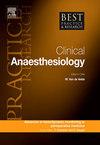局部麻醉,区域麻醉和癌症生物学
IF 2.8
3区 医学
Q1 ANESTHESIOLOGY
Best Practice & Research-Clinical Anaesthesiology
Pub Date : 2025-03-01
DOI:10.1016/j.bpa.2025.03.001
引用次数: 0
摘要
局麻药(LAs)在围手术期护理中已被广泛应用了一个多世纪。新出现的证据表明,LAs通过多种机制影响癌细胞生物学,包括调节肿瘤细胞增殖、凋亡和转移,以及与肿瘤微环境相关的过程,如血管生成和免疫反应。这些作用归因于LAs对膜蛋白的作用,如电压门控钠通道(VGSC)和caveolin-1,致癌途径,如PI3K/AKT/mTOR和RAS/MAPK/ERK轴,以及基因转录信号调节,包括NF-κB和STAT3等中间体。此外,LAs还通过促进caspase激活、诱导氧化应激、调节不同细胞器的功能和结构来调节癌细胞。LAs作为已建立的和实验性化疗药物的辅助剂的作用已在多个体外实验中进一步描述。体内模型也被用来证明LAs可能能够减轻动物的肿瘤负担和转移,突出了它们在癌症治疗中的潜在作用。然而,尽管有很好的临床前研究结果,需要进一步的研究来建立临床相关性并优化LAs在肿瘤手术中的应用。这篇综述文章的目的是总结目前可用的LAs和区域麻醉对肿瘤扩散影响的临床前证据。本文章由计算机程序翻译,如有差异,请以英文原文为准。
Local anesthetics, regional anesthesia and cancer biology
Local anesthetics (LAs) have been widely used for over a century in perioperative care. Emerging evidence suggests that LAs impact on cancer cell biology through multiple mechanisms, including modulation of tumor cell proliferation, apoptosis, and metastasis, as well as in processes related to the tumor microenvironment such as angiogenesis and the immune response. These effects are attributed to LAs effect on membrane proteins, such as voltage gated sodium channels (VGSC) and caveolin-1, oncogenic pathways, such as PI3K/AKT/mTOR and RAS/MAPK/ERK axis, and gene transcription signaling regulation, including intermediates such as NF-κB and STAT3. Furthermore, LAs modulate cancer cells by promoting caspase activation and inducing oxidative stress, as well as regulating different organelle's function and structure. LAs role as adjuvant agents for stablished and experimental chemotherapeutic drugs have further been described in multiple in vitro experiments. In vivo models have also been used to demonstrate that LAs might be able to reduce tumor burden and metastasis in animals, highlighting their potential role in cancer treatment. However, despite promising preclinical findings, further research is needed to establish clinical relevance and optimize the use of LAs in oncological surgery. The aim of this review article is to summarize the currently available preclinical evidence of the effects of LAs and regional anesthesia on cancer spread.
求助全文
通过发布文献求助,成功后即可免费获取论文全文。
去求助
来源期刊

Best Practice & Research-Clinical Anaesthesiology
ANESTHESIOLOGY-
自引率
0.00%
发文量
37
审稿时长
36 days
 求助内容:
求助内容: 应助结果提醒方式:
应助结果提醒方式:


